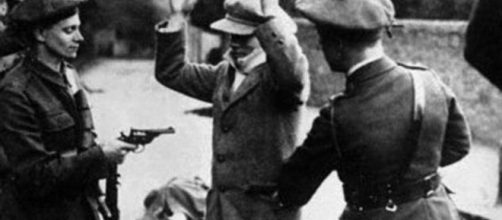ENGLISH HISTORY is dark and sordid affair to compile and read through, there is a significantly high level of suppression of information to allow the ‘British values’ rhetoric to be used repeatedly. March 25th1920 marks the day when Winston Churchill, British Secretary of State for War, sent the Black and Tans into Ireland. This was a costly error that helped republicanism to grow even stronger than previous, according to IrishCentral.
The move was in response to the 1916 Easter rising and the 1918 election, which saw Sinn Fein win 73% of the vote in a 32-county election.
Blood on English hands
In an attempt to suppress the Irish Rebellion, the war cabinet created the Black and Tans then sent them into Ireland, their intent was made clear from the very beginning. Lt. Colonel Gerald Smyth made an address to a group of new recruits where he told them that if “hands up” was not obeyed immediately to “shoot and shoot with effect.” He also said that if anyone was suspicious looking or had their hands in their pocket then they were to be shot immediately. But what was most chilling about this address was that he said:
“You may make mistakes occasionally and innocent persons may be shot, but that cannot be helped, and you are bound to get the right parties some time. The more you shoot, the better I will like you”.
(IrishCentral.com)
This speech was made to predominantly Irish citizens and this prompted Constable Jeremiah Mee to step forward and lay down his arms and resign. Smyth did order the arrest of Mee but other generals warned him off, subsequently, 13 others resigned with Mee and this became known as the Listowel Mutiny. But the Black and Tans continued onwards with their attempt to recruit and supress the Irish rebellion and as a result, the Irish made up of around 20% of the paramilitary force and Eunan O’Haplin wrote a book that outlined how the most violent were the Irish, rather than the British. This doesn’t excuse the British but highlights that they had pro-union support within the community.
Their reputation was bloody and violent, in one incident, troops torched 20 houses in Balbriggan. The soldiers also looted pubs, burned down a factory and beat two men to death during the raid. One of the more notorious figures within the paramilitary squad was Thomas D. Huckerby, whom killed 5 men, all of whom were unarmed and not involved with the IRA. November 1920 saw the Tans besieged the town of Tralee in revenge for the IRA abduction and killing of two local RIC men. They closed all the businesses in the town, let no food in for a week and shot dead three local civilians. In December 1920, they sacked Cork and destroyed a vast amount of the city centre.
There is a much more to read on the subject and understanding the violent past of England is vital to build a better future for all.

